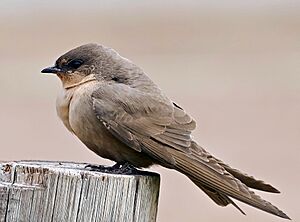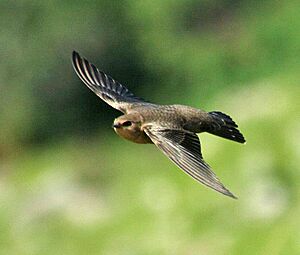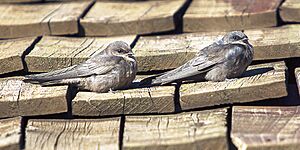Rock martin facts for kids
Quick facts for kids Rock martin |
|
|---|---|
 |
|
| At the Karoo National Park, Western Cape, South Africa. | |
| Conservation status | |
| Scientific classification | |
| Genus: |
Ptyonoprogne
|
| Species: |
fuligula
|
 |
|
|
Approximate range
|
|
| Synonyms | |
|
Hirundo fuligula Lichtenstein, 1842 |
|
The rock martin (Ptyonoprogne fuligula) is a small bird from the swallow family. You can find it living in central and southern Africa. These birds mostly live in mountains. But they also live in lower areas, especially where there are rocks or towns. Unlike most swallows, they don't always need to be near water.
Rock martins are about 12 to 15 centimeters (5 to 6 inches) long. They are mostly brown. Their upper chest and underwing feathers are a lighter brown. When they fly, you can see white patches on their tail. Male and female rock martins look alike. Young birds have light edges on their upper feathers. Rock martins hunt flying insects along cliffs. They fly slowly and glide a lot. Their call is a soft twittering sound.
Rock martins build a deep, bowl-shaped nest. They make it from mud pellets and line it with grass or feathers. They build nests under cliff overhangs or on buildings. They often reuse their nests. Rock martins usually nest alone. But small groups might nest close together. They lay two or three white eggs with brown and grey spots. Both parents sit on the eggs for 16–19 days. Then they feed the chicks. The young birds learn to fly in 22–24 days.
Rock martins can be hunted by fast birds like falcons. They can also get parasites. But there are many rock martins in a large area. Their numbers seem to be steady. So, they are not considered an endangered species.
Contents
About the Rock Martin's Name
The rock martin was first described in 1842. A German scientist named Martin Lichtenstein gave it the name Hirundo fuligula. Later, in 1850, another German scientist, Heinrich Gustav Reichenbach, moved it to a new group called Ptyonoprogne.
The name Ptyonoprogne comes from ancient Greek words. Ptyon means "a fan," which describes the shape of the bird's tail when it's open. Procne is a name from an old story about a girl who turned into a swallow. The second part of its name, fuligula, means "sooty-throated" in Latin. This describes its throat color.
The rock martin has three close relatives. They are the pale crag martin from North Africa, the dusky crag martin from Asia, and the Eurasian crag martin. All these birds belong to the Ptyonoprogne group.
Different Kinds of Rock Martins
There are a few different types of rock martins. They look slightly different in color or size. These differences change gradually across their homes. The types also breed with each other where their homes meet.
Some smaller, paler rock martins from North Africa are now often called a separate species. They are known as the pale crag martin. But the changes in their size and color are continuous. This means it's hard to say if they are truly different species.
Here are some of the main types of rock martins:
| Subspecies | |||
|---|---|---|---|
| Subspecies | Who named it | Where it lives | What makes it special |
| P. f. fuligula | (Lichtenstein, 1842) | Eastern Cape, South Africa. | This is the original type of rock martin. |
| P. f. fusciventris | (Vincent, 1933) | Southern Sudan and Ethiopia down to northern Mozambique. | It is smaller than the original type and has darker feathers. |
| P. f. bansoensis | (Bannerman, 1923) | West and central Africa. | It is small and has very dark feathers. |
| P. f. anderssoni | (Sharpe & Wyatt, 1887) | Southwestern Cape north to southern Angola. | It is similar in size to the original type, but its feathers are paler. |
| P. f. pretoriae | Roberts, 1922 | Eastern South Africa. | Its feathers are like the original type, but it is larger. |
What the Rock Martin Looks Like
The rock martin is about 12 to 15 centimeters (5 to 6 inches) long. Its upper body is earth-brown. It has a short, square tail with small white spots. These spots are near the tips of most tail feathers. Its chin, throat, and upper chest are cinnamon colored. The rest of its underside is brown, like its upper body.
Its eyes are brown, and its small beak is mostly black. Its legs are brownish-pink. Male and female birds look very similar. Young rock martins have light edges on their upper feathers. Other types of rock martins have slightly different colors or sizes.
The rock martin flies slowly. It flaps its wings quickly and then glides. It is a quiet bird. Its song is a soft, muffled twitter. Other calls include a "trrt" sound and a high-pitched "twee."
It is hard to confuse the rock martin with most other African swallows. It looks similar to other crag martins. The pale crag martin is smaller and lighter in color. The rock martin is a bit bigger than sand martins. It also has white tail spots and no dark band across its chest.
Where Rock Martins Live
Rock martins live in many parts of Africa. They are found as far north as Nigeria, Chad, and Ethiopia. They usually stay in the same area. Sometimes they move to lower places after breeding.
Their natural home is in hills or mountains. They like cliffs, deep valleys, and caves. They can live up to 3,700 meters (12,100 feet) high. But they also live in lower areas. This is especially true if there are rocks or buildings. They can even be found far from water. They often use buildings or bridges instead of natural cliffs.
Rock Martin Life Cycle
Building Nests and Raising Young
Rock martin pairs often nest alone. But sometimes, small groups of up to 40 pairs might nest close together. These birds protect their nesting area from other birds. When they breed depends on where they live and the weather. They often have two groups of chicks in a season. Sometimes they even have three. Breeding mostly happens in August and September.
Both adult birds build the nest. It takes several weeks. They use hundreds of mud pellets. They line the nest with soft, dry grass or feathers. The nest can be a half-cup shape if it's under an overhang. Or it can be bowl-shaped if it's on a sheltered ledge. They build nests on cliffs, in cracks, or on human-made structures. They often reuse the nest for their next chicks and in later years.
They usually lay two or three eggs. The eggs are off-white with brown or grey spots. Both parents sit on the eggs for 16–19 days until they hatch. They feed the chicks about ten times an hour. The chicks learn to fly in 22–24 days. After they first fly, the young birds might return to the nest to sleep for a few days.
What Rock Martins Eat
Rock martins mostly eat insects they catch while flying. Sometimes they will eat insects from the ground. When they are breeding, they fly back and forth along cliffs. They catch insects with their beaks near their nest. At other times, they might hunt low over open ground.
The insects they eat depend on what is available. This can include mosquitoes, flies, ants, and beetles. Rock martins often hunt alone. But large groups can gather at grass fires. They feast on insects trying to escape the fire. Outside of breeding season, groups of up to 300 birds might form where there is a lot of food. Cliff faces create air currents that gather insects near them. Crag martins use their flying skills to catch insects close to the cliffs.
Enemies and Pests
Some falcons are fast enough to catch swallows and martins in the air. Rock martins can be hunted by birds like the peregrine falcon and African hobby. Rock martins sometimes share their nesting spots with little swifts. These swifts sometimes take over the martins' nests. Rock martins can also have tiny pests called ticks.
How Many Rock Martins Are There?
The rock martin lives in a very large area, about 4.16 million square kilometers (1.6 million square miles). We don't know the exact number of rock martins in the world. But they are generally common. They are less common in Botswana and Namibia. Their population seems to be stable. This means their numbers are not going down. Because they live in such a large area and have many birds, they are not considered to be in danger. They are listed as a "least concern" species on the IUCN Red List.




